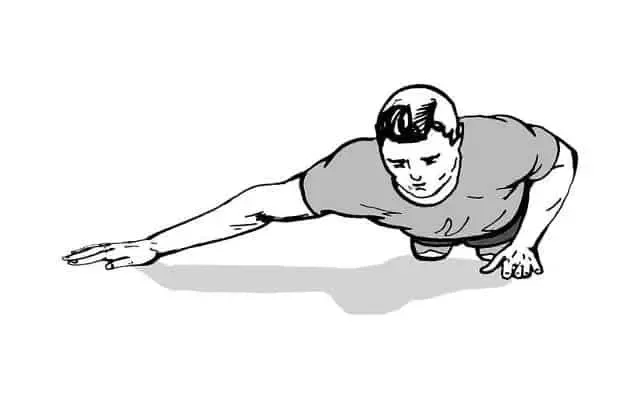Physical Address
304 North Cardinal St.
Dorchester Center, MA 02124

In the realm of fitness training, bodyweight exercises have gained immense popularity for their effectiveness and convenience. These exercises offer a plethora of benefits, from improving strength and endurance to enhancing overall body control and flexibility.
Among the various bodyweight exercises, Archer Pushups stand out as a challenging and rewarding movement that can take your fitness journey to the next level.
Archer Pushups are a progressive variation of regular pushups, serving as a stepping stone toward achieving the coveted single-arm pushup. They require a combination of strength, stability, and control, making them an excellent choice for individuals looking to challenge their limits and transform their bodies.
In this article, we delve into the world of Archer Pushups, exploring their technique, benefits, variations, and integration into your fitness routine. Whether you’re a beginner seeking to build a solid foundation or an experienced fitness enthusiast aiming to conquer advanced bodyweight exercises, understanding and mastering Archer Pushups will prove invaluable.
Get ready to discover how Archer Pushups can help you transform your physique, enhance your strength, and unlock your true potential. Let’s dive into this comprehensive guide and embark on a journey to push yourself beyond limits with the incredible Archer Pushup.
Archer Pushups can be considered as a natural progression from regular pushups, taking them to a whole new level of difficulty and effectiveness.
In a regular pushup, both hands are placed on the ground, shoulder-width apart, while the body is raised and lowered as a unit.
However, Archer Pushups introduce a unique twist by emphasizing unilateral movement and engaging the muscles in a slightly different manner.
While Archer Pushups share similarities with single-arm pushups, there are distinct differences between the two exercises. In single-arm pushups, the inactive arm is placed on the back, challenging the core and upper body strength.
On the other hand, Archer Pushups involve extending the resting arm horizontally on the ground or elevating it with the help of supporting objects, creating a wider range of motion and activating additional muscle groups.
To perform Archer Pushups correctly, proper body positioning and arm placement are crucial. Start by positioning your hands slightly wider than shoulder-width apart.
The working arm is placed in the standard pushup position, while the resting arm extends horizontally on the ground or is elevated on a supporting object.
The height of the supporting object should be between 6 to 12 inches to maintain the challenge and engagement of the muscles.

Maintain a straight line from head to feet, engaging your core and glutes to stabilize your body throughout the exercise. As you descend, keep your elbow close and tight to your side, activating the chest, triceps, and shoulder muscles.
Ensure that the forearm of the working arm remains upright, maximizing activation in the triceps and pectoral muscles.
By understanding the nuances of body positioning and arm placement in Archer Pushups, you can optimize the engagement of specific muscle groups and progress towards mastering this challenging exercise.
In the next section, we will explore the benefits of incorporating Archer Pushups into your fitness routine and the muscle groups they target.
Table of Contents
Effects of the exercise routine and workouts will only be visible if you perform the exercises correctly and follow the techniques at each step – till you begin the next rep. Archer pushup is no different.
Now, let’s talk about the correct technique for performing the archer push-up.
To perform Archer Pushups effectively, follow these step-by-step instructions:
Proper form and body alignment are crucial for maximizing the effectiveness of Archer Pushups and minimizing the risk of injury. Here are some key points to keep in mind:
To avoid common mistakes and prevent injuries while performing Archer Pushups, consider the following tips:
By following these guidelines and paying attention to your form, you can perform Archer Pushups safely and effectively, maximizing the benefits of this challenging exercise.
In the next section, we will discuss the frequency and progression of Archer Pushups to help you incorporate them into your fitness routine.
One of the key benefits of incorporating Archer Pushups into your fitness routine is the development of strength and endurance. This exercise requires significant upper body strength to support the unilateral movement and maintain proper form.
By challenging your muscles in this way, you can progressively increase your strength and endurance over time. The combination of pushing and stabilizing forces engages multiple muscle groups, leading to overall improvements in upper body strength.
Archer Pushups also contribute to improved posture and shoulder stability. As you perform this exercise, you engage the muscles in your shoulders and upper back, promoting proper alignment and reducing the risk of shoulder injuries.
The emphasis on stability and control helps strengthen the supporting muscles around the shoulder joints, leading to enhanced posture and better overall shoulder function.
The Archer Pushup is an effective compound exercise that engages multiple muscle groups in your upper body and core. Understanding the specific muscles targeted during this exercise can help you maximize your workout and achieve optimal results. Here are the primary muscles worked during Archer Pushups:
Additionally, Archer Pushups also engage secondary muscles such as the biceps, forearms, quadriceps, and glutes to a lesser extent.
By understanding the muscles targeted during Archer Pushups, you can focus on maintaining proper form and engage these muscles effectively. This knowledge can assist in creating a well-rounded upper body workout routine and achieving your fitness goals.
In the next section, we will discuss the frequency and progression of Archer Pushups to help you optimize your training and achieve your fitness goals.

As discussed, archer push-up is an extension of a regular push-up with a little modification, where one arm is in resting position. It requires a lot more strength and stamina to perform continuous reps of archer push-up. But when performed accurately, the results of archer push-up can be quite rewarding.
Archer push-up targets the shoulders and the chest muscles. It also works on the wing muscle which is directly under your armpit. It also works on the triceps and the abdominals.
If performed perfectly, it sets you free from lower back pain as well. It also works on your biceps, abs, and quads.
If you’re a beginner, it is advisable to start with regular push ups. Once you’ve strength to execute at least 30 reps continuously, you can then think of progressing to the archer push up.
If you’re an intermediate and have perfected regular push-ups with some continuous reps, you can switch onto archer push-ups. However, keep the rep range towards the lower end and focus more on the technique to perfect it.
If you’re an advanced level athlete, you can perform the workout five times a week, and maybe make a progression to the single arm push-up.
To continue challenging yourself and progressing with Archer Pushups, you can experiment with different hand placements and body positioning. Here are some variations to consider:
Introducing elevated surfaces or props can intensify the difficulty of Archer Pushups. Consider the following options:
As you build strength and proficiency in Archer Pushups, you can work towards the ultimate goal of performing single-arm pushups. Here’s a suggested progression:
Remember, progression should be gradual and tailored to your individual capabilities. Listen to your body and only progress when you feel ready to take on the next challenge.
In the final section, we will summarize the key points discussed and provide some concluding remarks on the benefits and potential of Archer Pushups in your fitness journey.
To effectively integrate Archer Pushups into your fitness routine, it’s important to consider frequency and sets/reps. Here are some guidelines to help you get started:
To maximize the benefits of Archer Pushups and create a well-rounded fitness routine, it’s important to complement them with other exercises that target different muscle groups. Consider incorporating the following exercises:
It’s essential to tailor your Archer Pushup routine to your individual fitness goals and current fitness level. Consider the following:
Remember to listen to your body, take rest days as needed, and gradually progress to avoid overexertion or injury. Consulting with a fitness professional or personal trainer can provide valuable guidance in tailoring your routine to meet your specific goals.
In the concluding section, we will summarize the key takeaways and highlight the transformative potential of Archer Pushups in your fitness journey.
In the concluding section, we will summarize the key points discussed throughout the article and highlight the transformative benefits of Archer Pushups for achieving strength, endurance, and overall fitness.
Patience and persistence, makes your body accommodate any calisthenics exercise. And workouts which seemed impossible initial becomes less challenging over time. To curate boredom, and keep workout more challenging you can always try push up variation.
Archer push up can be performed with a number of different variations to make it more challenging.
1. You can lift one, two, three or even four fingers of your resting arm from the floor. It brings more body load on the working arm.
2. You can also try to place your resting arm on some kind of elevated object. Maybe like a dumbbell, kettlebell or a medicine ball.
3. You can try the decline archer push up, or try it with one leg elevated in the air. However, make sure you shift the elevated leg one by one.
By increasing the complexity of the exercise, you help yourself to build a muscular chest.
Archer Pushups can present certain challenges along the way. Here are some common difficulties you may encounter and tips to overcome them:
If you’re a beginner or have certain limitations, it’s important to modify the Archer Pushup exercise to suit your abilities. Consider the following modifications:
Plateaus and a lack of motivation can be common challenges during any fitness journey. Here are some strategies to overcome them:
Remember, consistency and patience are key. Embrace the journey, celebrate small victories, and stay focused on your long-term goals. With perseverance and the right mindset, you can overcome challenges, break through plateaus, and continue progressing in your Archer Pushup journey.
In the concluding section, we will summarize the main points discussed and emphasize the transformative potential of Archer Pushups in achieving your fitness goals.
When it comes to bodyweight exercises, there are several variations that target similar muscle groups and provide comparable benefits to Archer Pushups. Understanding the similarities and differences between these exercises can help you choose the ones that align with your fitness goals and preferences.
Here’s a comparison of Archer Pushups with other bodyweight exercises:
Each of these exercises has its unique benefits and challenges. Incorporating a variety of bodyweight exercises, including Archer Pushups and their variations, can help you achieve a well-rounded upper body workout routine, improve strength and stability, and prevent plateaus in your training.
Remember, it’s essential to prioritize proper form and gradually progress the difficulty of the exercises based on your fitness level and capabilities.
Archer Pushups are more advanced variations of pushups and may not be suitable for absolute beginners. It’s recommended to develop a solid foundation of strength through regular pushups before attempting Archer Pushups.
The number of Archer Pushups you should do depends on your fitness level and goals. Start with a comfortable number of repetitions and gradually increase as you get stronger. Aim for quality over quantity and focus on maintaining proper form throughout.
It’s generally recommended to give your muscles time to rest and recover between workouts. Incorporate Archer Pushups into your routine 2-3 times per week, allowing for adequate rest days in between to promote muscle recovery and prevent overuse injuries.
While Archer Pushups primarily target the chest muscles, they also engage the shoulders, triceps, and core muscles. The exercise provides a comprehensive upper body workout, activating multiple muscle groups simultaneously.
Archer Pushups, like other bodyweight exercises, are effective for building strength and muscle tone. However, they alone won’t make you bulky. To significantly increase muscle size, additional factors such as nutrition, genetics, and specific training protocols are necessary.
Wrist discomfort can be alleviated by ensuring proper hand placement. Distribute the weight evenly through your palms and fingers, avoiding excessive pressure on the wrists. Additionally, performing wrist mobility exercises and using pushup handles or parallettes can provide added support.
Focus on maintaining a stable core and engage your abdominal muscles to improve balance. Start with the modified variations, such as kneeling Archer Pushups, to develop stability and gradually progress to full Archer Pushups.
Begin with easier pushup variations, such as standard or wide pushups, to build strength in the chest, shoulders, and triceps. As you get stronger, gradually introduce Archer Pushup progressions, such as using an elevated surface or reducing assistance, to work your way up to full Archer Pushups.
Remember to consult with a healthcare professional before starting any new exercise program, especially if you have pre-existing medical conditions or injuries.
In the concluding section, we will summarize the key points discussed and highlight the transformative benefits and potential of Archer Pushups for your fitness journey.
In conclusion, Archer Pushups are a challenging and effective bodyweight exercise that can help you build strength, improve posture, and target multiple muscle groups. By understanding the proper technique, incorporating variations, and progressively advancing your routine, you can reap the benefits of this exercise and work towards achieving single-arm pushups.
Whether you’re a beginner or an advanced fitness enthusiast, Archer Pushups offer a versatile and customizable workout option that can be integrated into your fitness routine. Remember to prioritize safety, listen to your body, and consult with a healthcare professional if needed. With dedication, consistency, and a focus on proper form, Archer Pushups can be a valuable addition to your fitness journey.